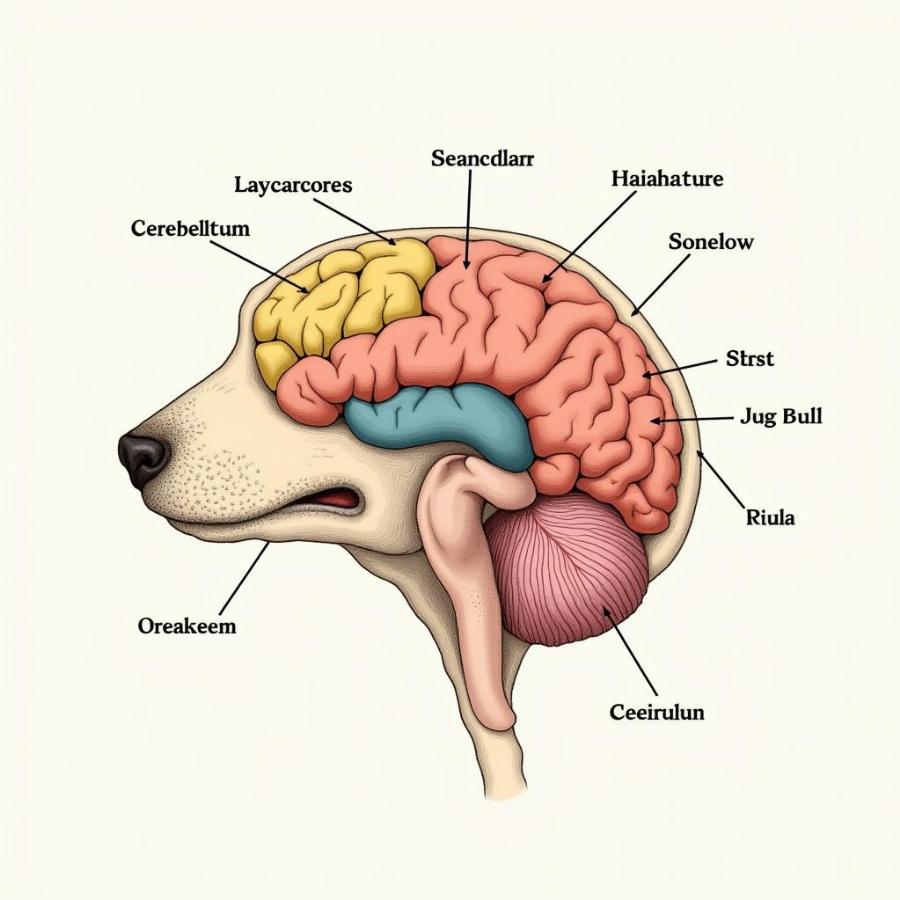Understanding the dog brain anatomy provides valuable insights into their behavior, learning abilities, and overall well-being. This complex organ controls everything from basic functions like breathing and heart rate to more complex processes such as emotions, learning, and memory. By delving into the intricacies of the canine brain, we can strengthen our bond with our furry companions and provide them with the best possible care.
Decoding the Dog Brain Structure
The dog brain, similar to the human brain, is divided into several key regions, each with specific functions. These regions work in harmony to orchestrate the dog’s physical and mental activities. The cerebrum, the largest part of the brain, is responsible for higher-level cognitive functions such as learning, memory, and problem-solving. The cerebellum, located at the back of the brain, plays a crucial role in coordinating movement and balance. The brainstem, connecting the brain to the spinal cord, controls vital functions such as breathing, heart rate, and sleep-wake cycles.
 Cấu trúc não chó
Cấu trúc não chó
How Does a Dog’s Brain Compare to a Human’s?
While the basic structure of the dog brain is similar to a human’s, there are significant differences in size and development. The human brain is considerably larger than a dog’s brain, even when accounting for body size. This difference reflects the greater complexity of human cognitive abilities. However, specific areas of the dog brain, such as the olfactory bulb responsible for smell, are significantly more developed than in humans, explaining their exceptional sense of smell.
The Role of the Dog Brain in Behavior and Training
Understanding the dog brain anatomy is essential for effective training and behavior modification. Dogs learn through association and reinforcement, and the brain plays a central role in these processes. Positive reinforcement strengthens neural pathways associated with desired behaviors, making them more likely to occur in the future. Consistency and patience are key to successful training, as the dog’s brain needs time to adapt and form new connections.
Understanding Dog Brain Development
A dog’s brain continues to develop throughout its life, although the most rapid growth occurs during puppyhood. Early socialization and exposure to various stimuli are crucial for proper brain development and can significantly impact the dog’s behavior in adulthood. dog head anatomy is an important aspect of this development.
Common Questions About Dog Brain Anatomy
What part of the dog brain controls smell?
The olfactory bulb, located at the front of the brain, is the primary center for processing smells. It is significantly larger and more complex in dogs than in humans, contributing to their extraordinary sense of smell.
How does the dog brain process emotions?
The limbic system, a complex network of structures deep within the brain, plays a crucial role in processing emotions in dogs, similar to humans. This system influences behaviors such as fear, aggression, and joy.
Expert Insights
Dr. Emily Carter, a renowned veterinary neurologist, emphasizes the importance of understanding dog brain anatomy for responsible pet ownership: “Knowing how your dog’s brain works can help you better understand their behavior, anticipate their needs, and provide a more enriching and fulfilling life.”
Another expert, Dr. David Miller, a canine behaviorist, adds: “By understanding the principles of canine brain function, we can tailor our training methods to be more effective and humane, strengthening the bond between humans and their canine companions.”
Conclusion
Dog brain anatomy is a fascinating and complex subject that offers valuable insights into the inner workings of our beloved pets. By understanding the structure and function of the dog brain, we can enhance our ability to communicate, train, and care for them effectively. This knowledge empowers us to provide them with a happy, healthy, and stimulating life, strengthening the unique bond we share.
FAQ
- What is the biggest part of the dog’s brain? The cerebrum.
- What does the cerebellum do? Controls movement and balance.
- How does a dog learn? Through association and reinforcement.
- What is the olfactory bulb? The primary center for processing smells.
- Why is understanding dog brain anatomy important? It helps us better understand their behavior and provide better care.
- How does the dog brain develop? It develops throughout its life, with the most rapid growth during puppyhood. dog ear drawing can even show some aspects of this development.
- What part of the brain controls emotions? The limbic system.
You Might Also Be Interested In
If you found this article helpful, you might also be interested in learning more about dog water on the brain or anatomy of dogs ear. Also, understanding the anatomy of the eye dog can provide further insights into your dog’s senses.
Beaut Dogs: Your Ultimate Resource for Canine Care
Beaut Dogs is your one-stop destination for all things dog-related. We provide reliable, helpful, and in-depth information on a wide range of canine topics, from breed characteristics to health and training tips. When you need assistance, please contact us at Email: [email protected] to get detailed and accurate answers from Beaut Dogs. We’re here to help you provide the best possible care for your furry friend. Visit https://beautdogs.com today!